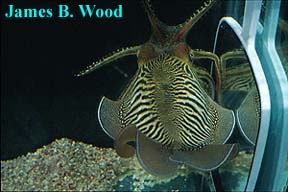
 |
| Home | What's New? | Cephalopod Species | Cephalopod Articles | Lessons | Bookstore | Resources | About TCP | FAQs |
The Colourful World of Cephalopods - Cephalopod body patterning III<< Cephalopod Articles | byHow does the cephalopod control these mechanisms for changing colour and shape?  As it turns out, each chromatophore is attached to a nerve ending. This has two advantages. The first is that one chromatophore can be expanded to show colour, while the chromatophore beside it is not. This allows the production of highly contrasting patterns like zebra-stripe. The second advantage is that they can exhibit colour as quickly as their neurons can fire, which is on the order of milliseconds.
As it turns out, each chromatophore is attached to a nerve ending. This has two advantages. The first is that one chromatophore can be expanded to show colour, while the chromatophore beside it is not. This allows the production of highly contrasting patterns like zebra-stripe. The second advantage is that they can exhibit colour as quickly as their neurons can fire, which is on the order of milliseconds.
Iridophores are not under nervous control and have traditionally been thought, like leucophores, to stay the same colour. Under laboratory conditions, however, they change colour in response to differing concentrations of the hormone acetylcholine (ACh). Increasing concentrations of ACh temporarily change the utlrastructure (the skeleton or scaffolding that organizes the inside of a cell) of the iridophores, resulting in a shift in the reflected colour from blue to gold. The fine details of this phenomenon have not yet been elucidated. Lastly, papillae are erected by muscles that are under nervous control. Therefore, like chromatophores, they are quick to respond. Click here to find out why cephalopods use body patterning. To go back to page 2, click here.
| ||||||
| Home | What's New? | Cephalopod Species | Cephalopod Articles | Lessons | Resources | About TCP | FAQs | Site Map | |
 |
The Cephalopod Page (TCP), © Copyright 1995-2026, was created and is maintained by Dr. James B. Wood, Associate Director of the Waikiki Aquarium which is part of the University of Hawaii. Please see the FAQs page for cephalopod questions, Marine Invertebrates of Bermuda for information on other invertebrates, and MarineBio.org and the Census of Marine Life for general information on marine biology. |